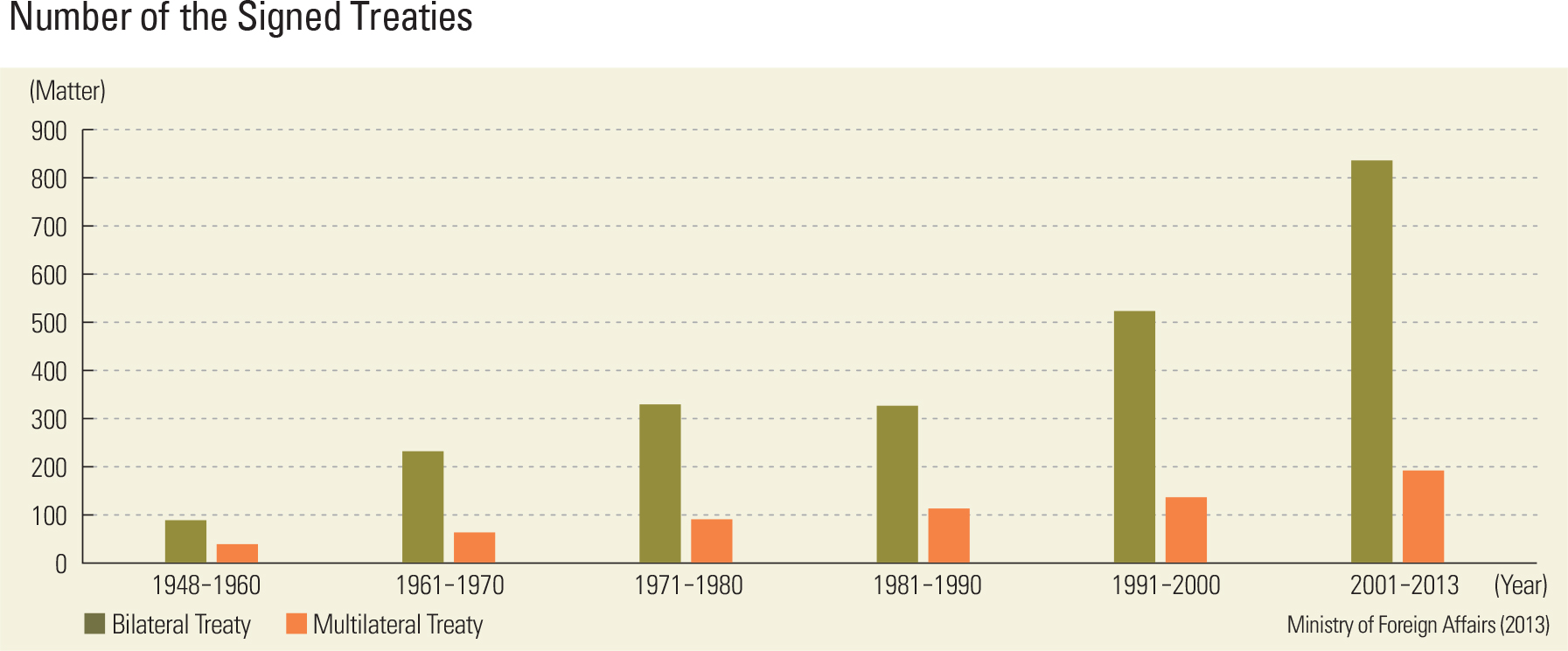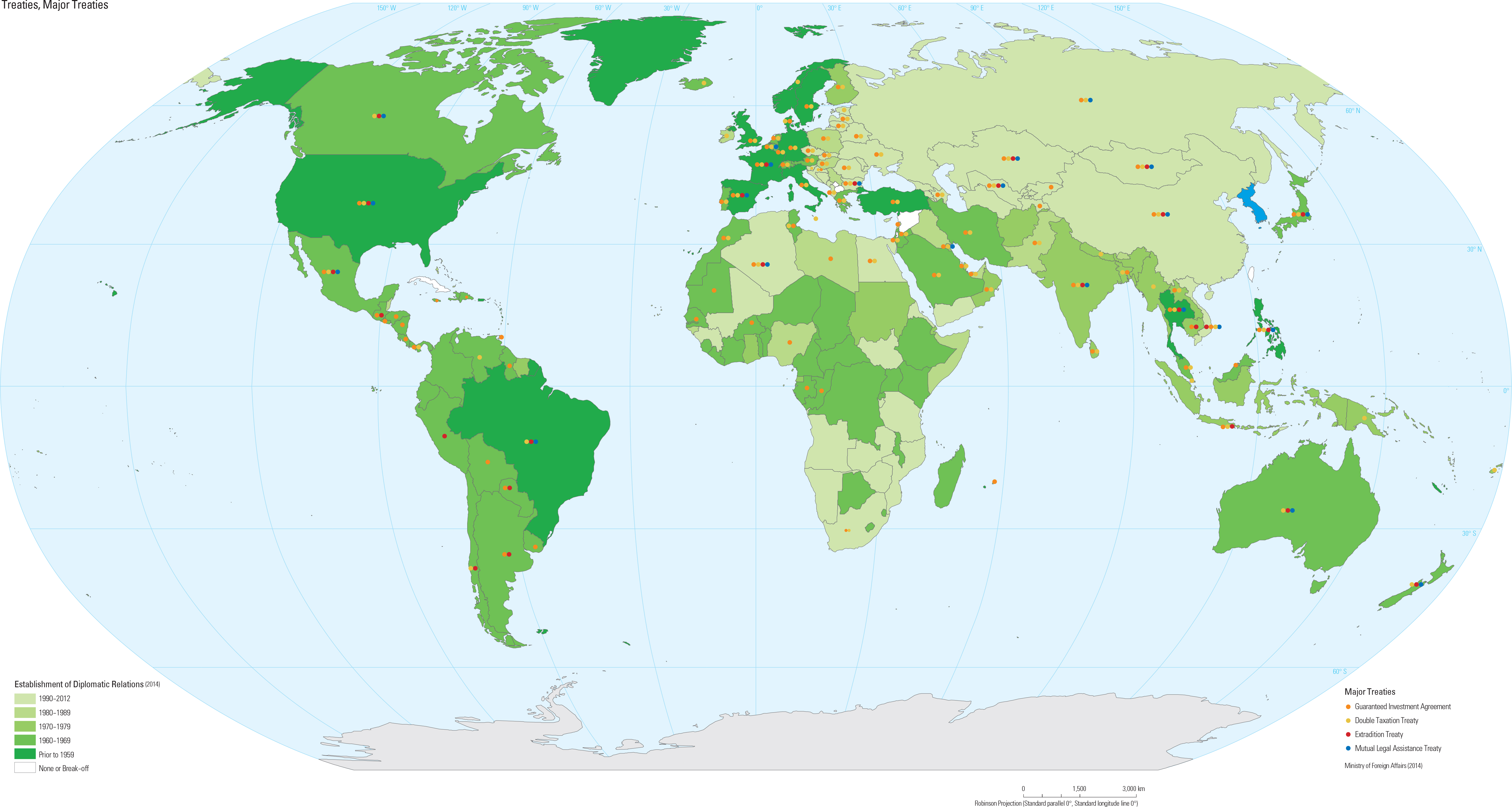This is the era of globalization, a time that truly tests all countries politically, economically, and culturally, and Korea has risen to the challenges of this growing globalization on all fronts, both at home as well as in its relationships with other nations in Asia and beyond. Not only has the Korean government continued to expand its diplomatic ties with other countries for the purpose of deepening political, economic, social, and cultural exchanges with nations abroad, it has also entered the international sphere through the fostering of important treaties with other countries such as the Investment Promotion and Protection Agreements and the Assistance in Criminal Matters Act. Korean diplomatic establishments continue to expand worldwide with embassies, missions, and consulate generals opening in countries across the globe. The movement of people across the Korean border has also increased, both with Korean citizens traveling abroad for both personal and professional reasons and with the steadily rising influx of visitors to Korea from tourists to foreign workers to new immigrants.
Korea is now a key player on the world political stage. With its entry into the United Nations and other UN-affiliated organizations, Korea now joins other nations in the pursuit of peacekeeping, human rights, economic development, and environmental protection. The Korean government has also successfully developed bilateral or regional Free Trade Agreements (FTAs) to complement the existing multinational trading system, which has allowed Korea to overcome the economic challenges presented by an unbalanced domestic distribution of wealth and population as well as the stark realities of an aging populace and an overall low birth rate. A treaty of amity signifies the establishment of diplomatic relations with other countries. And in the formal forging of such a relationship, the two countries enter into formal cooperation on various aspects including political, economic, social and cultural issues. As of December 2013, South Korea maintained diplomatic relations with 188 countries among the 191 United Nations member states as well as with two non-UN member countries, the Cook Islands and the Vatican. The UN member countries that still do not have a treaty with South Korea are Macedonia, Syria, and Cuba. Kosovo, a non-UN member country, also does not have a diplomatic relationship with South Korea.
The map shows when Korea established diplomatic relations with other countries. From the inception of the Korean government in 1948 right through the early 1960s the number of countries with diplomatic ties to Korea was 16. By the end of that decade the number rose dramatically to 65. Half of these new ties were with non-allied nations that were under-developed countries in Asia, Africa, and Latin America (also known as the third world countries). Korea worked to build practical and cooperative relationships with many of these developing countries in large part because of their significant ties to the international community via organizations such as the United Nations. South Korea established diplomatic relations with 30 additional countries during the 1970s and another 22 countries in the 1980s. During the Cold War period, South Korea upheld the Hallstein Doctrine and did not develop diplomatic ties with the countries that had official ties to North Korea. It also adhered to a policy that refused North Korea’s participation in international conferences. That policy was withdrawn officially as part of the 1973 joint agreement with North Korea regarding peaceful reunification. In the mid-1980s, the Soviet Union adopted a reform-oriented open-door policy, and as the tensions of the Cold War era have gradually dissolved into an atmosphere of mitigation and reconciliation ever more openness was observed. In 1989, the US-Soviet Union Malta summit was held, and the two countries agreed to discontinue mutual hostility and end the Cold War. In the same year, a democratic revolution took place in the Eastern Bloc countries, and in the following year East Germany and West Germany were united. As the Soviet Union was officially dissolved in December 1991, the Cold War eventually ended. Along with the changing international situation, the South Korean government pursued the so-called “Northern Diplomacy” and established diplomatic relations with Eastern European countries, starting with Hungary in 1989. This was followed by the historic formation of diplomatic relations with the Soviet Union in 1990.
A treaty refers to an “international agreement, written in the name of the specific format across the country signed, and governed by international law, regardless of whether it is implemented in a single document or two or more related documents in there, and of the name of the specific” (Vienna Convention on Treaty Law – Article 2, Section 1 (a)). Although the above definition pertains to the nations, generally speaking, a treaty includes international agreements between national and international organizations or between international organizations. The map displays the countries that signed treaties with South Korea regarding matters such as guaranteed investment agreements, double taxation treaties, extradition treaties, mutual legal assistance treaties, and so forth. Specifically, 87 countries signed investment guarantee agreements; 78 signed double taxation agreements; 26 signed extradition treaties, and 22 countries signed criminal judicial cooperation treaties. Among these, 15 countries, including the United States, China, and Japan signed all of these treaties. The graph shows the number of treaties signed by year. It indicates that as the number of countries with diplomatic ties with South Korea has increased, the number of countries with bilateral treaties signed increased as well. Multilateral treaties, which are more difficult to establish than bilateral treaties, have also increased steadily.

